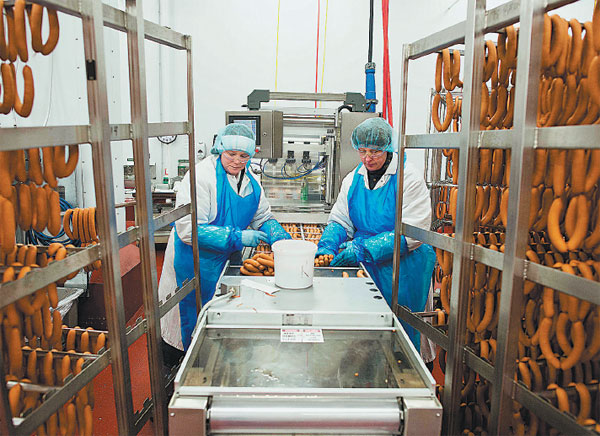Beef seen declining by ANZ as Australia defies trend on drought
|
Workers hand package skinless wieners at the Smith Provisions Co production facility in Erie, Pennsylvania. US pork and poultry production is up 5 percent in 2015 from a year earlier and a large supply of hogs is forecast over the next six months, pushing prices of competing meats lower. Ty Wright / Bloomberg |
Global beef prices may decline on rising US pork and poultry supply and on signs that demand from some emerging markets is weakening, Australia & New Zealand Banking Group Ltd said.
US pork and poultry production is up 5 percent in 2015 from a year earlier and a large supply of hogs is forecast over the next six months, pushing prices of competing meats lower, analyst Paul Deane said. Beef exports from Brazil were the weakest in three years in the first quarter on lower slaughter and weaker demand. Prices in Australia may still have room to climb as they are 90 cents cheaper than US rates, the biggest discount at any time in the decade prior to 2012, he said.
"Global beef prices are one of the last remnants of the commodity super-cycle, but fundamentals point to lower prices ahead," Deane wrote in a report on Monday. "Financial and economic trends in some emerging markets are also unfavourable for beef prices."
The US cattle herd as of Jan 1 grew 1.4 percent from the prior year to 89.8 million head, marking the first increase in herd size since 2007, according to the US Department of Agriculture. Wholesale beef prices have climbed 5.2 percent this year while pork is little changed, USDA data show. Australian cattle prices will be determined by local weather, ANZ said.
"The Australian cattle market is running its own course however, with domestic weather and cattle supply for slaughter masking global trends," Deane said.
A record 80 percent of Australia's Queensland state, the country's biggest beef producer, is in drought after a patchy summer wet season, the government said last week. Already dry conditions may be compounded by the formation of an El Nino, which heralds a drier winter and spring in Australia's east.
The Eastern Young Cattle Indicator, which measures prices at saleyards in the country's east, capped an eighth weekly climb on Friday. Prices were at a record A$4.765 ($0.8) a kilogram on Friday. A sustainable level for the gauge is A$5.20 to A$5.50 in 2015-2016, according to ANZ.

























